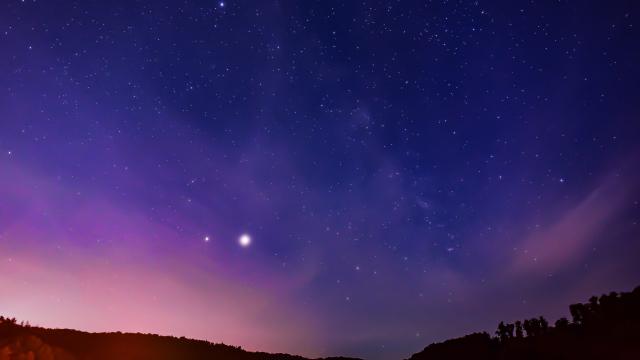If the skies are clear enough when you live, you should plan on gazing upward early next week to witness what I can only liken to a great cosmic romance. Though the pandemic is rampant and your town or city might be buried under a deluge of snow, the heavens have promised an escape from the drudgery here on Earth with an absolutely jam-packed celestial calendar this month.
A great “kiss” between Saturn and Jupiter is poised to deliver some great stargazing on December 21, unmatched in its brilliance since the Middle Ages. Experts are also calling the phenomenon a “Christmas star,” because we’re all in clear need of a holiday miracle.
Here’s why you should mark the event in your calendar, and how to see it unfold in a patch of sky near you.
It’s really called the great conjunction
Though it’s called a “kiss” in conversational parlance, the phenomenon has long been called a conjunction by astronomers. It occurs when two planets cross paths, or come close enough together to appear in close proximity from a vantage point on Earth. Aside from occurring on the Winter Solstice — which is pure coincidence according to NASA — this year’s conjunction carries great historic implications.
According to the space agency, this will be the closest conjunction in 400 years:
It’s been nearly 400 years since the planets passed this close to each other in the sky, and nearly 800 years since the alignment of Saturn and Jupiter occurred at night, as it will for 2020, allowing nearly everyone around the world to witness this “great conjunction.”
As reported previously by Lifehacker, the two planets will be o.1 degrees apart at the kiss’ peak, which is roughly 1/5 the size of the diameter of a full moon. NASA puts that visual into perspective, noting that the planets “will appear so close that a pinkie finger at arm’s length will easily cover both planets in the sky.” Don’t be fooled by its appearance in the sky, because the two planets will still be hundreds of millions of miles apart.
It’s a gradual process that takes place over the course of days, but it will eventually culminate on December 21, perhaps validating all of your fantasies of a Christmas miracle. And it just might be: According to the space agency, this will be the closest convergence of Saturn and Jupiter since the year 1226.
How does the kiss, aka conjunction, aka ‘Christmas star’ work?
It’s a natural product of planetary orbits, really, and it occurs every 20 years. As Henry Throop, astronomer in the Planetary Science Division at NASA Headquarters in Washington, explains in a statement: “You can imagine the solar system to be a racetrack, with each of the planets as a runner in their own lane and the Earth toward the centre of the stadium.”
Throop explains that a conjunction could occur at any point in the year, but it all hinges on planetary positions:
The date of the conjunction is determined by the positions of Jupiter, Saturn, and the Earth in their paths around the Sun, while the date of the solstice is determined by the tilt of Earth’s axis. The solstice is the longest night of the year, so this rare coincidence will give people a great chance to go outside and see the solar system.
How to see it
Luckily, the conjunction is so close this year you won’t need a telescope or binoculars to see it. (You could still use them though, as they can’t really hinder your view).
NASA provides a helpful guide to taking in the delightful scenes:
Find a spot with an unobstructed view of the sky, such as a field or park. Jupiter and Saturn are bright, so they can be seen even from most cities.
An hour after sunset, look to the southwestern sky. Jupiter will look like a bright star and be easily visible. Saturn will be slightly fainter and will appear slightly above and to the left of Jupiter until December 21, when Jupiter will overtake it and they will reverse positions in the sky.
The planets can be seen with the unaided eye, but if you have binoculars or a small telescope, you may be able to see Jupiter’s four large moons orbiting the giant planet.
Even if it’s cold out, you might want to brave the frigid conditions: This will be the closest conjunction of the two planets until the year 2080.

Leave a Reply
You must be logged in to post a comment.